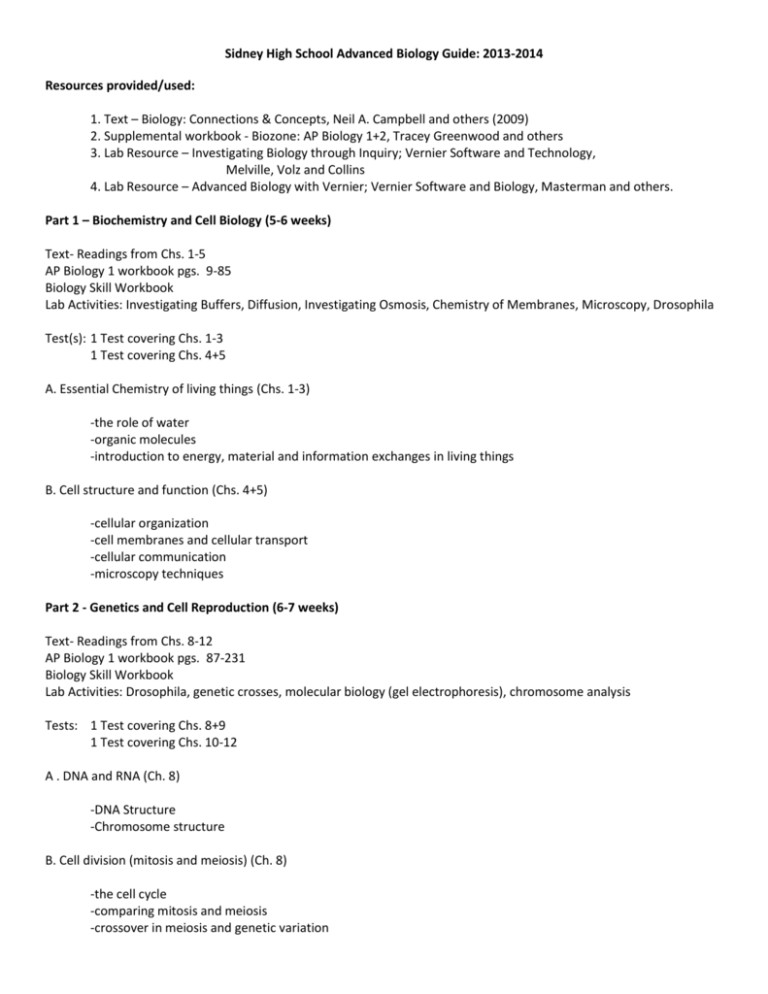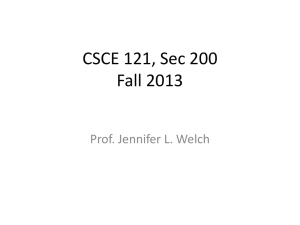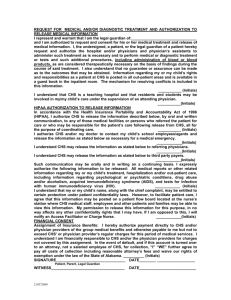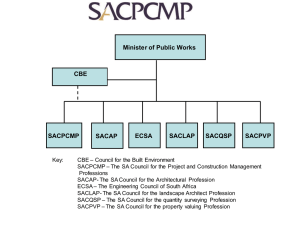Advanced Biology Outline
advertisement

Sidney High School Advanced Biology Guide: 2013-2014 Resources provided/used: 1. Text – Biology: Connections & Concepts, Neil A. Campbell and others (2009) 2. Supplemental workbook - Biozone: AP Biology 1+2, Tracey Greenwood and others 3. Lab Resource – Investigating Biology through Inquiry; Vernier Software and Technology, Melville, Volz and Collins 4. Lab Resource – Advanced Biology with Vernier; Vernier Software and Biology, Masterman and others. Part 1 – Biochemistry and Cell Biology (5-6 weeks) Text- Readings from Chs. 1-5 AP Biology 1 workbook pgs. 9-85 Biology Skill Workbook Lab Activities: Investigating Buffers, Diffusion, Investigating Osmosis, Chemistry of Membranes, Microscopy, Drosophila Test(s): 1 Test covering Chs. 1-3 1 Test covering Chs. 4+5 A. Essential Chemistry of living things (Chs. 1-3) -the role of water -organic molecules -introduction to energy, material and information exchanges in living things B. Cell structure and function (Chs. 4+5) -cellular organization -cell membranes and cellular transport -cellular communication -microscopy techniques Part 2 - Genetics and Cell Reproduction (6-7 weeks) Text- Readings from Chs. 8-12 AP Biology 1 workbook pgs. 87-231 Biology Skill Workbook Lab Activities: Drosophila, genetic crosses, molecular biology (gel electrophoresis), chromosome analysis Tests: 1 Test covering Chs. 8+9 1 Test covering Chs. 10-12 A . DNA and RNA (Ch. 8) -DNA Structure -Chromosome structure B. Cell division (mitosis and meiosis) (Ch. 8) -the cell cycle -comparing mitosis and meiosis -crossover in meiosis and genetic variation Sidney High School AP Biology Guide cont. Part 2 – Genetics and Cell Reproduction cont. C. Chromosomes and inheritance (Ch. 9) -chromosomes, genes and alleles -Mendel’s experimentation and laws of inheritance -genetic crosses -patterns of inheritance D. Genetic expression and variation (Chs. 10-12) -the genetic code and transfer of genetic information -cellular differentiation -gene mutation -sources of gene mutations -Techniques in studying genetics (genetic engineering, cloning, gel electrophoresis) Part 3 – Evolution (6-7 weeks) Text- Readings from Chs. 13-15 AP Biology 1 workbook pgs. 233-349 Biology Skill Workbook Lab Activities: Population Genetics, Artificial Selection in Yeast A. Genetic Change in Populations (Ch. 13) -Evolution Theory -Natural Selection -allele frequencies in populations -genetic drift -artificial selection in crops or animals B. Evidence of Evolution in biological organisms (Ch. 13) -the fossil record of life on Earth -evidence in living organisms (structural, molecular) -relatedness in organisms C. Mechanisms of Evolution (Chs. 13+14) -natural selection and speciation -extinction -patterns of evolution D. Origin of Living Organisms on Earth (Chs. 14+15) -from prokaryotes to eukaryotes -history of life on Earth Tests: 1 or 2 Tests on Chs. 13-15 SEMESTER TEST on CHS. 1-15 Part 4 – Evolution and Biological Diversity 1. The Diversity of Organisms Text-Readings from Chs. 16-20 AP Biology 1 Workbook pages 268-340 Biology Skills Workbook Lab Activities: A. Patterns of evolution -body plans in multicellular organisms B. Survey of the Diversity of Life -representative microbial life, bacteria, protists, fungi -representative plant and animal phyla C. Phylogenetic classification-summary of distinguishing characteristics of plant and animal groups D. Evolutionary relationships -Evidence of relatedness among groups/types of organisms -Study of evolutionary relationships -classification of living organisms Test – one test over Chs. 16-19 (possibly open book) Additional special reading/writing assignments Lab Activities: Bacterial Growth and Isolation 2. Structure and Function of Plants and Animals Text Readings from Chs. 20-28 and 31-33 AP Biology 2 Biology Skills Workbook Lab Activities: Plant Growth – Wisconsin Fast Plants, Physiology of circulation and respiration A. Reproduction, Growth and Development -patterns of reproduction and development in plants and animals and how are they regulated -significance of alternation of generations in the major groups of plants B. Structural, Physiological and Behavioral Adaptations -organization of cells, tissues and organs in determining structure and function in plants and animals -relationships of structure and function in organ systems. -interaction of organ systems - adaptations and their contributions to the success of various land plants and animals. C. Response to the Environment - responses of plants and animals to environmental cues - hormones regulation of plant and animal responses 1 Test on Chs. 20-28 1 Test on Chs. 31-33 PART 5 – Ecology Text: Readings from Chs. 34-38 Laboratory ActivitiesAdditional specific reading/writing excercises 1. Population dynamics -population growth -biotic and abiotic factors in population growth 2. Communities and Ecosystems -energy flow in an ecosystem (food chains, food webs, trophic levels etc.) -nutrient cycles in ecosystems -biotic and abiotic factors in ecosystems and their affect on interaction among species 3. Global issues – How do humans affect biogeochemical systems? One Test on Chs. 34-38 SEMESTER TEST on Chs. 16-28, 31-38








